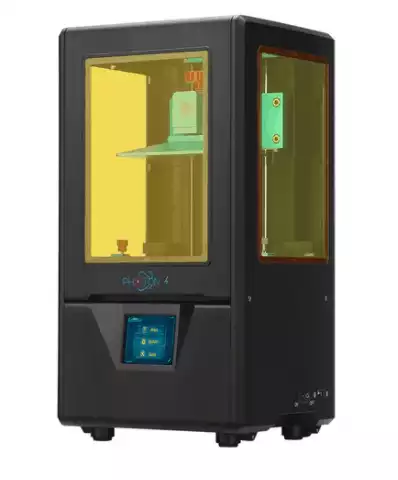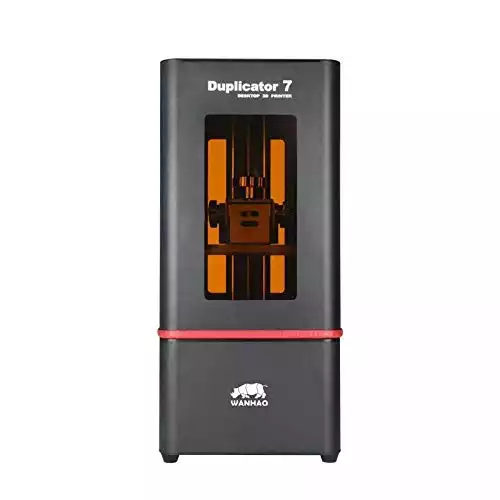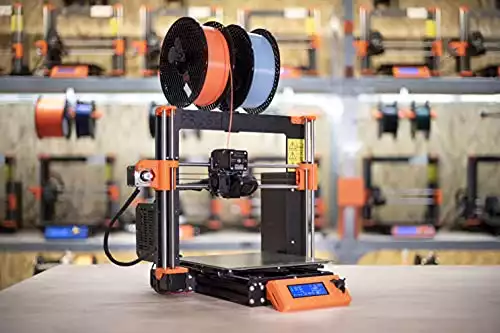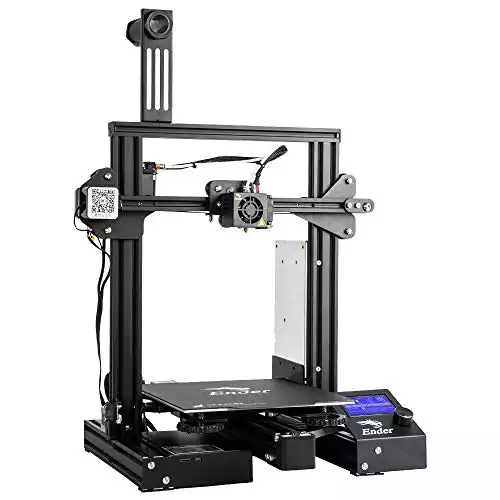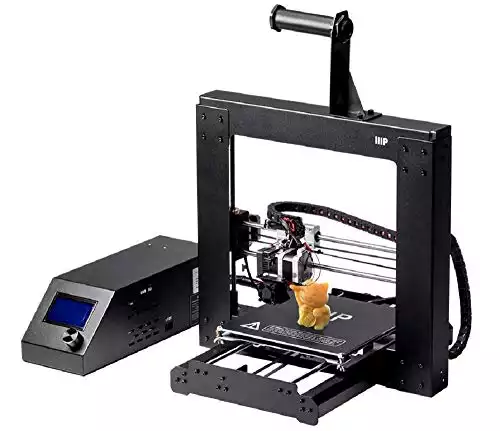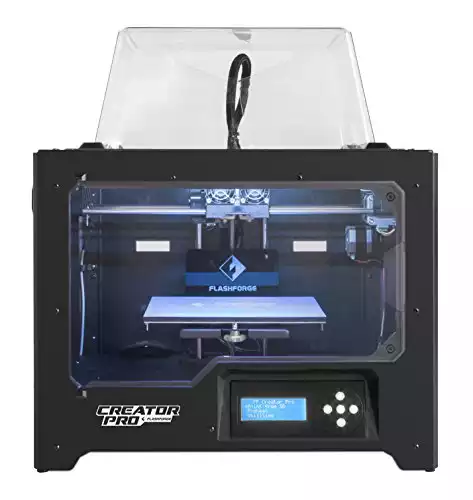- Flashforge Creator 3 Review [2022]: Our Honest Opinion - April 5, 2022
- Anycubic Photon Review [2022]: Will This Work for You? - April 5, 2022
- X-Carve Review [2020]: Is This CNC Machine Right For You? - April 4, 2022
Table of Contents
List of the Top 5 Best 3D Printers for Miniature Printing
- AnyCubic Photon S – Best Overall 3D Printer for Miniatures
- Wanhao Duplicator 7 – Best for Large Batch Printing
- Prusa i3 MK3 – Best for Beginners
- Monoprice Maker MP10 – Best Budget
- FlashForge Creator Pro – Most Versatile
- Creality Ender 3 – Best Open-Source 3D Printer
Building off of the original Photon, the Photon S is targeted specifically at the hobbyiest user, ensuring excellent prints for any experience level. Print precise miniatures in minutes.
- Filament-based printers, also known as FFF or FDM 3D printers
- Resin-based, or SLA 3D printers
AnyCubic Photon S – Best 3D Printer for Miniatures (Overall)
Our favourite 3D printer for miniatures is the AnyCubic Photon printer. This resin-based unit can print your favorite miniatures with incredible quality. The unit is more detailed than almost any other 3D printer on the market and stays within a reasonable price range. The Photon offers a maximum layer resolution that checks in at 25 microns, which is the highest of any of the products on our list. The Photon is a top of the line SLA 3D printer that comes with a UV LED light source. Your miniatures will print from top to bottom. You’ll notice this is the opposite direction of the bottom to a top method that FDM printers use. If you’re in the market for a 3D printer, you can’t go wrong with the Photon, which will create very detailed and smooth products no matter how complex they are. Not much assembly is required with this printer. Right out of the box, it’s easy to set up and get going. The unit comes with a solid frame, along with a touchscreen interface that lets you see a preview of your miniature before it prints. The unit provides an easy process for levelling the bed and ships with a slicer that users find simple and user-friendly. When it comes to creating complicated and detailed miniatures, the Photon is one of the best printers on the market for getting the job done.Building off of the original Photon, the Photon S is targeted specifically at the hobbyiest user, ensuring excellent prints for any experience level. Print precise miniatures in minutes.
Pros of the AnyCubic Photon S
- Simple and easy to set up
- Print offline
- Comes completely assembled
- Intuitive touchscreen user interface
- Easy to maintain
- Print quality provides amazing detail
Cons of the AnyCubic Photon S
- The material can be on the expensive size
- Smaller print size than other 3D printers
Special Discount Deal Alert: The Anycubic Photon is on sale for a RECORD price of around $174 here (normally $379). That’s $200 off the list price and the steepest discount we have seen ALL YEAR!Further Reading:
- Anycubic Photon Review [Full Review]
- Anycubic Photon vs Elegoo Mars
- Anycubic Kossel Delta Review
- Anycubic i3 Mega Review
Wanhao Duplicator 7 – Best for Larger Print Jobs

The Wanhao Duplicator 7 DLP uses the vat photopolymerisation 3D printing technology. DLP stands for Digital Light Processing. For 3D printing the Wanhao Duplicator 7 DLP selectively cures liquid resin layer after layer in order to build an object.
Pros of the Wanhao Duplicator 7
- Large base
- Open material platform
- High detail printing
- Larger printing size than AnyCubic Photon
- Sturdy and stable frame
Cons of the Wanhao Duplicator 7
- Materials can be costly
- Customer support isn’t very reliable
- Build volume is limited
Original Prusa MK3 – Best 3D Printer for Beginners
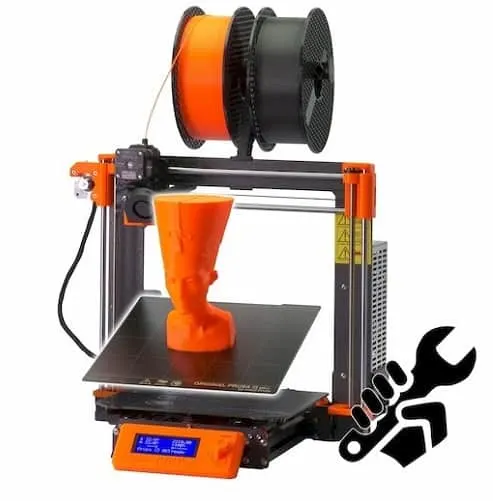
Basic features magnetic PEI Spring steel sheet EINSY RAMBo Base plate Silent Trinamic drivers with 256 microstepping Maximum travel speed: 7.874 in per second. The Original Prusa i3 MK3S+ is the latest version of their award-winning 3D printers.
Pros of the Original Prusa MK3
- Great for beginners
- Automated bed leveling platform
- Excellent 3D print quality
- Built-in filament types sensors
- Quiet printing process
- Panic feature pauses print job if necessary
- Magnetic build platform can be removed
Cons of the Original Prusa MK3
- No enclosure provided
- Translucent materials create issues with filament types sensor
Creality Ender 3 – Best open-source 3D printer
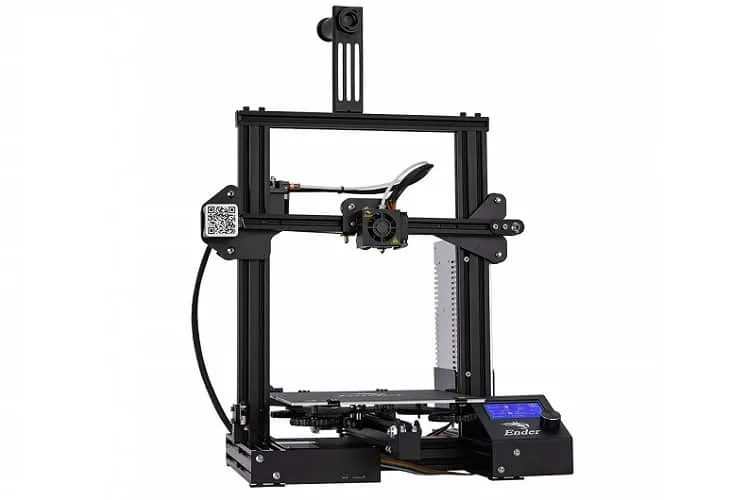
Put simply, the Ender Pro has worked out all of the kinks, glitches, and inconsistencies that were shipped with the original Ender 3. You can save some money by going with the Ender 3, but it's not worth it unless you are very technical.
Pros
- Open-source 3D printer, so ideal for upgrading and customizing
- It has a decent build volume for printing miniatures
- BuildTak-like heated build plate creates great prints
- Assembly is easy and straightforward, especially for beginners
Cons
- Build plate can wobble, which can lead to stability issues
- You need to calibrate this 3D printer manually
Further Reading
- Anycubic i3 Mega vs Ender 3 Compared: Which One Is Right For You?
- Ender 3 vs Prusa i3 MK3 [2022]: Which is Best?
- Ender 3 Pro vs Ender 3 Compared [2022]: What’s the Difference?
Monoprice MP 10 – Best 3D Printer on a Budget
The large 8 x 8 inches build plate and generous 7 inches vertical spacing means that you can print larger, more complex models.
Pros of the Monoprice Maker Select
- Decent print size (large build plate)
- Good print quality
- Simple to set up
- Heated bed (print bed)
- Sturdy frame
Cons of the Monoprice Maker Select
- May need upgrades out of the box
- Bed levelling is a manual process
- Not as good printing smaller miniatures
FlashForge Creator Pro – Most Versatile 3D Printer

Aviation level aluminum plate with a thickness of 6.3mm guarantee its surface is completely flat and will not warp during heating process.
Pros of the Creator Pro
- Includes dual extruder option
- The metal frame is enclosed
- Excellent support
- Dual colour printing option
- Supports third-party filaments
- Solid print quality
- Larger build plate
Cons of the Creator Pro
- Built-in software is limited
- Bed levelling requires manual adjustments
- Very heavy
- Flashforge Creator X Review
- Flashforge Dreamer Review
- Flashforge Creator Pro vs Dremel Idea Builder
- Flashforge Creator Pro vs LulzBot Mini
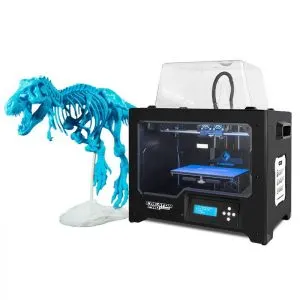
| Ender 3 | ||||||
|
Type |
Resin 3D Printer |
Resin 3D Printer |
ABS/PLA/PETG |
ABS/PLA/TPU |
ABS/PLA/PVA |
ABS/PLA/TPU/PETG |
|
Resolution |
25 microns |
35 microns |
50 microns |
100 microns |
100 microns |
100-400 microns |
|
Filament |
N/A |
N/A |
1.75 mm |
1,75 mm |
1.75 mm |
1.75 mm |
|
Volume |
4.5×2.6×6.1 inches |
4.7×2.7×7.9 inches |
9.8×8.3×8.x inches |
7.9×7.9×7.1 inches |
8.9×5.8.5.9 inches |
8.7″ x 8.7″ x 9.8″ |
|
Connection |
USB |
USB |
SD Card/USB |
USB/ SD Card |
SD Card/ USB |
SD Card/ USB |
|
Weight |
14.6 pounds |
26.5 pounds |
14 pounds |
20 pounds |
32.7 pounds |
16.5 pounds |
FDM or SLA 3D Printer?
FDM 3D printers make use of an extruder with a hot-end, which allows for melting the filament. Once the filament is melted, it’s then deposited onto the build platform (build plate). This is what creates the 3D model. However, FDM printers do so a single layer at a time.Where to Buy a 3D Printer
There are plenty of places you can use when you’re ready to buy your 3D printer. However, keep in mind that the type of 3D printer you want may dictate where it’s available. Like nearly anything else, you can usually find the 3D printer you want on Amazon. If it’s not available there, you may also try other retailers like MatterHackers.com.NOTE: You can order the Anycubic Photon S – our top pick for miniatures – directly via the Anycubic site here.If you can’t find the printer you want in any of those places, you can always try to contact the manufacturer directly.
Discount Alert: The Anycubic Photon is on sale for a RECORD around $174 here (normally $379). That’s $200 off the list price and the steepest discount we have seen ALL YEAR!
FAQs
Answer: There are several reasons to print your own 3D miniatures, one of which is cost. The average cost of printing an unpainted miniature typically falls in the $5-$ ten range.
Answer: If you aren’t concerned with quality, you can print off a miniature object in roughly 10 minutes. However, a more complex, high-quality, and detailed object can take as little as a few hours or as much as a day to finish.
Take a look at the software on your 3D printer to get an idea of how long it will take for your miniature to complete.Answer: While ABA has better properties when it comes to mechanics, it’s more difficult to use when 3D printing than PLA. For 3D printers, PLA is ideal if you’re focusing on aesthetics. On the other hand, ABD is ideal for strength, stability, and durability.
Something else to keep in mind is that ABS has been known to warp during printing.Answer: There are many different types of materials that are used when 3D printing. We’ve mentioned PLA and ABS, however, some objects can be printed with titanium, wax, polycarbonate, epoxy resins, and even nylon.
Answer: If you’re new to 3D printing, take a moment and read the following tips to give you a good starting point when looking for a printer.
Answer: Before you purchase your 3D printer, know what you plan on printing. There is a significant difference between printing devices for your desk and printing large-scale production pieces.
Also, ask yourself how often you will print, how much time you want to invest in 3D printing, and where the 3D printed objects will be used.Answer: Typically, a 3D printer that offers plenty of safety features is well-designed. For instance, a quality printer will probably cool the heated bed and nozzle when a printing job finishes. Additionally, some 3D printers will point the nozzle away from the object if you pause the job.
Answer: You’ll notice in the table above that the resolution of 3D printers is measured in a unit called microns. Usually, FDM printers are on the lower end of the spectrum, offering around 25 microns.
By comparison, resin-based printers usually reside on the higher end, around 100 microns. With an FDM printer, you can quickly and easily adjust the resolution. For smoother printing, being able to adjust the belt tension and layer height is paramount. Finally, remember that a resin 3D printer requires precision from their lasers. Keep an eye out for a resin printer that you can adjust based on the micron count detailed in the printer’s specifications.Answer: It can be easy to forget about high-end features as you look for a 3D printer that suits your needs. However, if you want things like heated glass beds, touchscreen interfaces, and dual filament options, be sure to add them to your list of must-haves.
Answer: You’ve found the 3D printer you want to buy, and you’re ready to pull the trigger. Before you do, take a moment and look for the customer support offered by the manufacturer. It is just a social media logo, or are there actual ways to reach a real-live person?
3D printing is more complicated than traditional printing, so if something goes wrong or you aren’t sure how to proceed in a certain situation, having someone to speak with could make your 3D printing experience.


